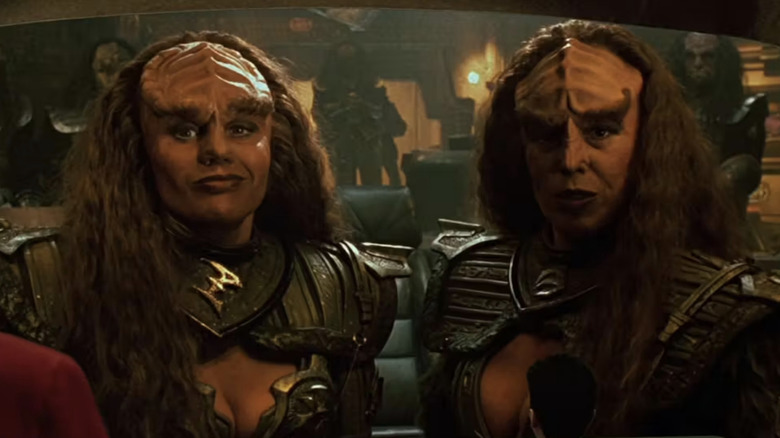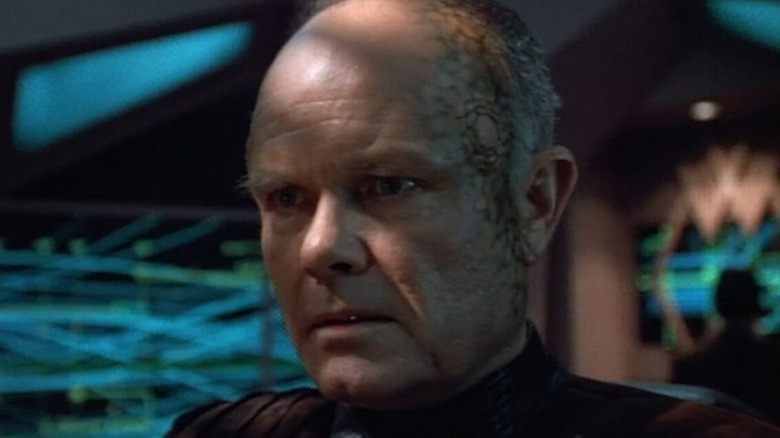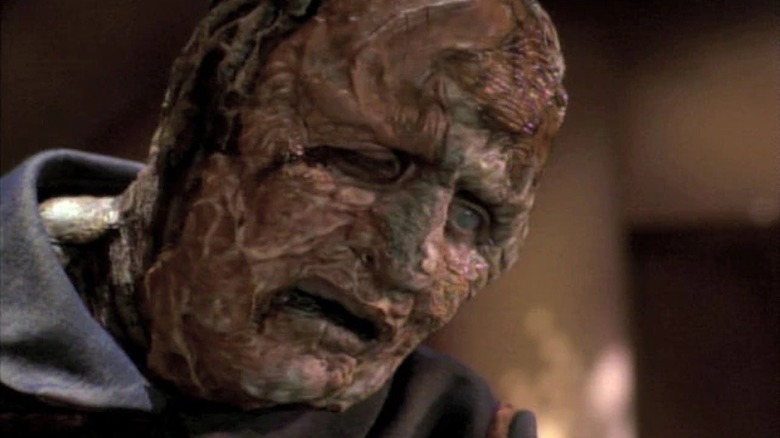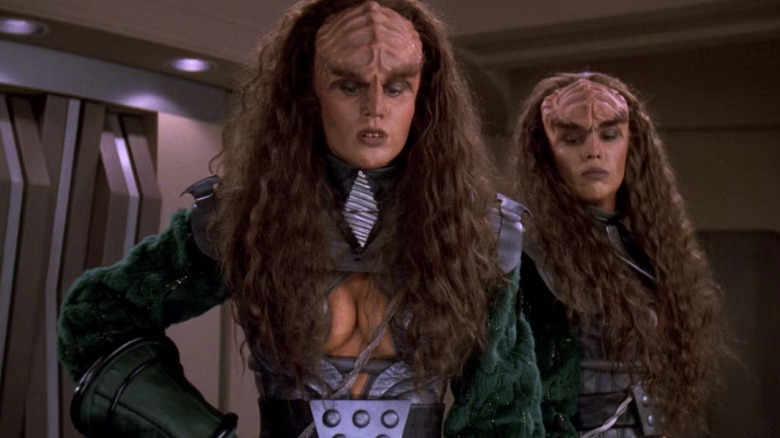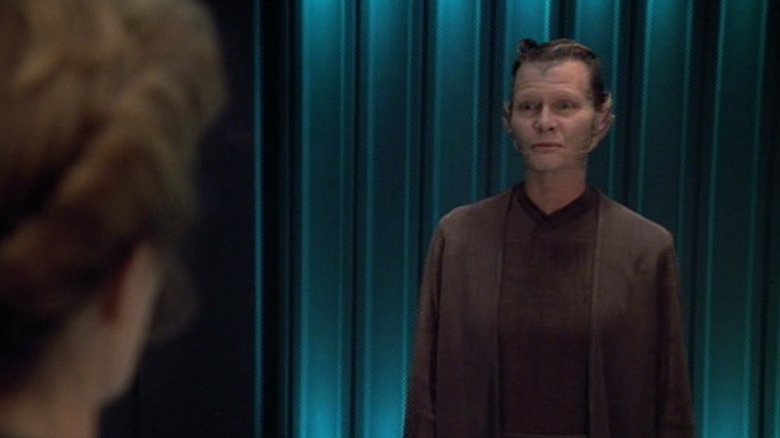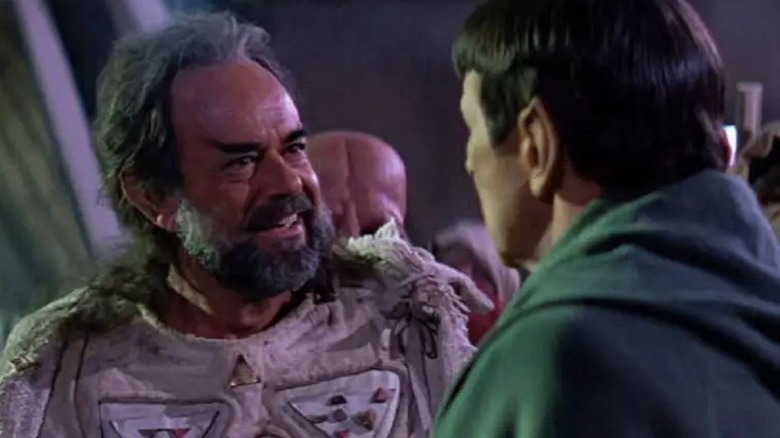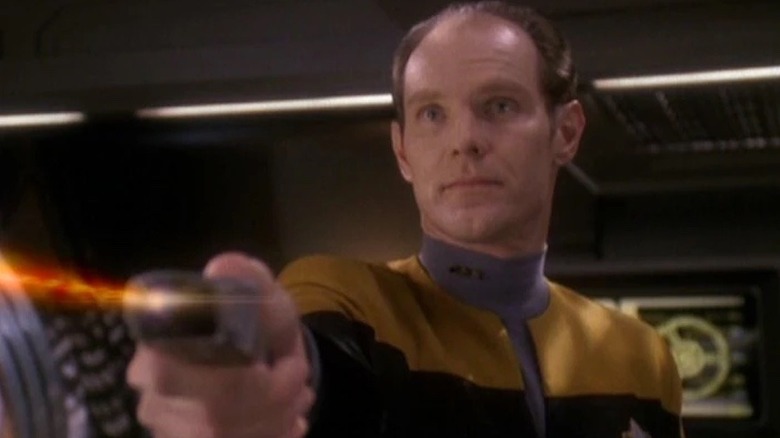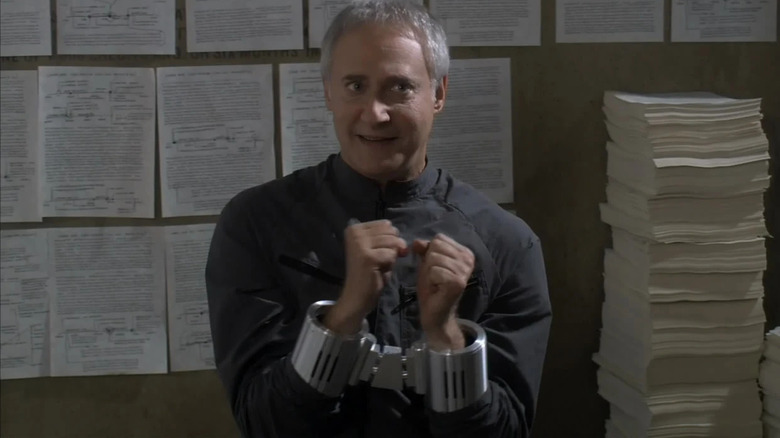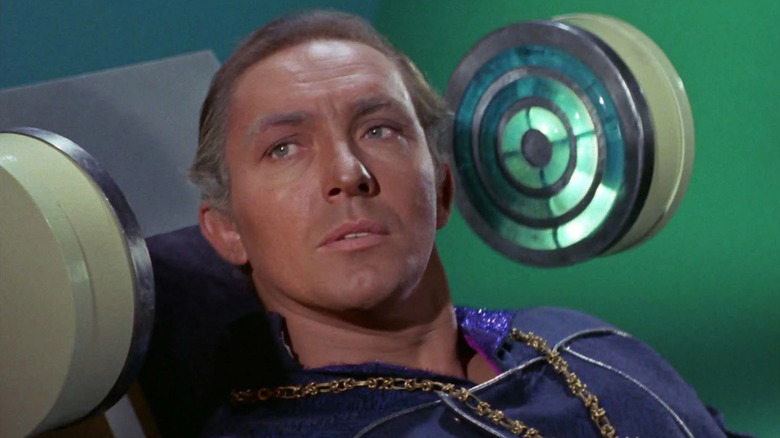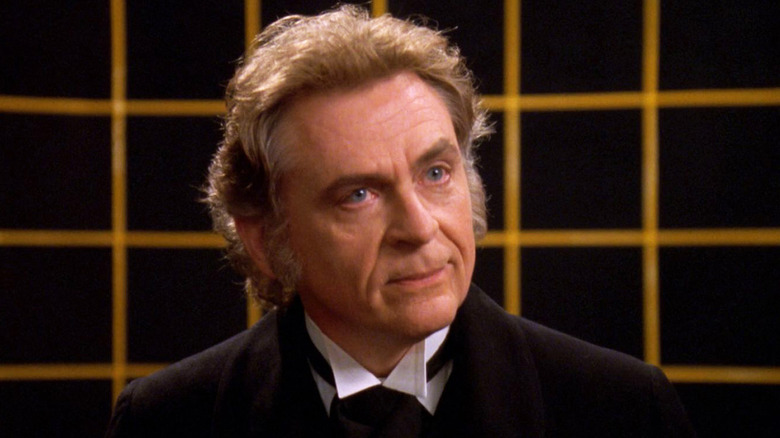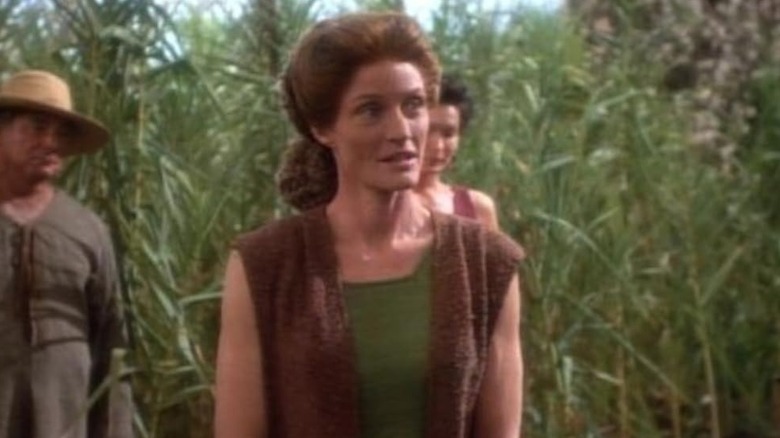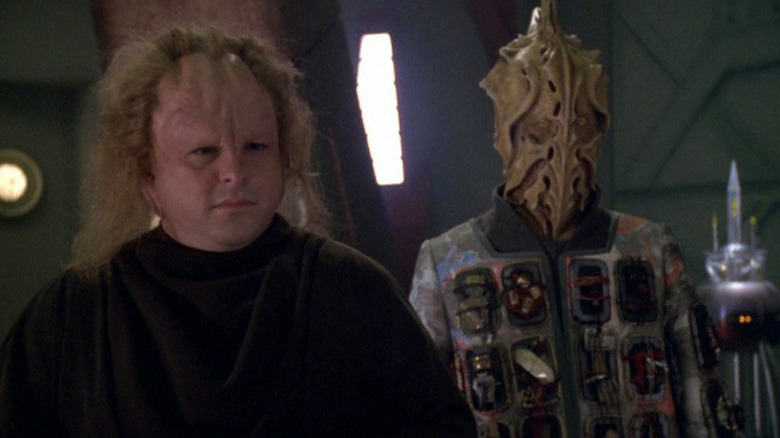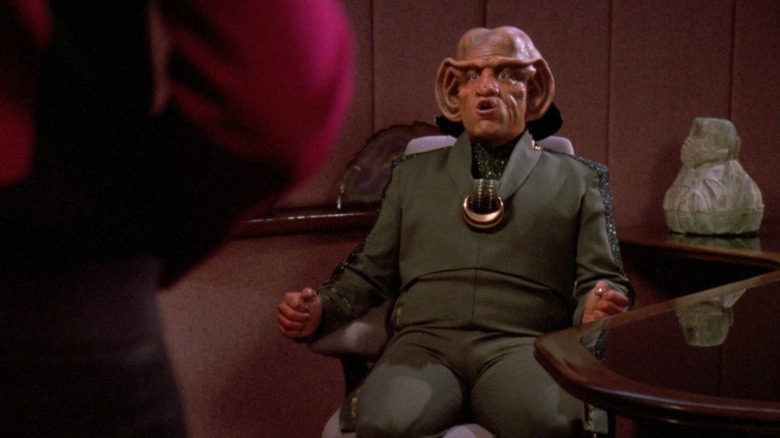15 Most Underrated Star Trek Villains Of All Time
"Star Trek" has been around for six decades, boasting more than a dozen TV shows and just as many movies, with more on the way. Beloved for its optimistic future populated by intrepid explorers, it's science fiction at its best. But it's also home to some of the greatest villains in fiction, from the dastardly Khan to the warrior Klingons.
Unfortunately, with so many movies and TV episodes, there are too many villains to give them all the recognition they deserve. So while pop culture regularly celebrates "Star Trek's" best villains, there are so many more that are underrated: Deeply compelling characters, terrifyingly powerful adversaries, and figures who dominated their stories through screen presence alone. But worry not, because now is the time to give them the spotlight. So take the helm, set thrusters to full, and prepare to leave spacedock, because these are the 15 most underrated "Star Trek" villains of all time.
Annorax
Admittedly, Annorax gets rated highly among Trek adversaries, even making our ranked list of best "Star Trek" villains, and it's easy to see why. He's a genocidal monster with a personal mission, wiping out entire civilizations to resurrect his dead wife and bring his people's empire back to power. But the "Voyager" villain played by Kurtwood Smith ranked at the bottom of our list, and there's an argument to be made that he should be rated far higher.
Thanks to his specialized time ship — that he created himself — Annorax already possesses one of the most powerful vessels in all of "Star Trek," one that is capable of annihilating entire planets not just from existence, but from history, altering reality to his whim. Despite this, he's also a profoundly layered character, a tragic, sympathetic villain whose goals are noble and understandable. In the finest tradition of the greatest fictional villains ever conceived, though, he uses deadly methods to achieve those goals. Not only is Annorax an underrated "Trek" villain, but he might be the greatest "Trek" villain ever conceived.
The Vidiians
Introduced in the very first season of "Star Trek: Voyager," the Vidiians are another tragic villain whose methods are horrific, but whose goals are sympathetic. Their entire race is afflicted by a disease called The Phage, which eats away at their bodies from the inside out. Attempting to save themselves from extinction, they've perfected the means to replace their organs and tissue with that of others. This has led to them becoming a race of quasi-cannibals, abducting innocent people and harvesting them for body parts.
In some ways, the Vidiians are no different than the Borg, using the bodies of other races to continue their existence. Unfortunately, they never reached their full narrative potential, and were neutered towards the tail end of the series when it was revealed that the Phage had been cured off-screen. But during their time as human-scavengers, the Vidiians — viewed by many as a mere nuisance in the early part of "Voyager" — are a devastatingly powerful race whose insidiousness belies a complicated history that's been almost entirely unexplored.
Admiral Leyton
"Star Trek" has a long history of evil admirals, affectionately known to fans as 'Badmirals': High-ranking Starfleet officers who go rogue, with their own missions at odds with Federation ideals, usually putting them in a life-or-death struggle with our heroes. Though their methods, means, and intents vary, the worst of the bunch might be Admiral Leyton, whose attempted coup of Starfleet and the Federation nearly succeeded.
It's in the "Star Trek: Deep Space Nine" two-parter, "Homefront" and "Paradise Lost," that Leyton uses the threat of a Dominion takeover of Earth as the pretext to put the planet under martial law and enact sweeping security measures that would render "freedom" a word of the past. And he has plenty of high-ranking Starfleet brass on his side. Thanks to Captain Sisko and his stalwart crew, though, Admiral Leyton's plan is thwarted. But we've never seen an internal takeover of Starfleet get very far, and Leyton very nearly pulled it off, making him easily one of the most dangerous Admirals to ever wear the uniform on-screen.
Kodos the Executioner
Yes, "Star Trek" has two characters named Kang and Kodos: Where did you think the writers of "The Simpsons" got those names from? It's not even the only detail that diehard "Simpsons" fans know about the pair, either. Nevertheless, it was in the 1966 episode "Conscience of the King" that we first met Kodos the Executioner, a legendary tyrant in Federation history who wiped out half the population of the planet Tarsis IV, where a young James T. Kirk lived. Facing the threat of starvation following a famine, Kodos elected to declare martial law and execute 50% of the population — chosen entirely at random — as a fair and balanced way to ensure their survival.
As you might imagine, many fans have likened Thanos and his mission to "balance the universe" in "Avengers: Infinity War" to Kodos. Well, if Thanos is among the worst villains in the Marvel Cinematic Universe, surely Kodos should rank just as high in "Star Trek," yet he's never mentioned in the same breath as the likes of Khan or the Borg Queen. But with the death he dealt on a mass scale, and a ruthless rationale, he's easily one of the most deadly madmen in "Trek" history.
The Duras Sisters
The Klingons are probably the most famous adversaries that the various crews in "Star Trek" have had to contend with, from Kang and Koloth in the original series to T'Kuvma and L'Rell in "Star Trek: Discovery." But it's the Duras Sisters from "The Next Generation" that never seem to get as much love. In their first appearance in the two-part episode "Redemption," Klingon sisters L'Ursa and B'Tor proved their mettle as the toughest pair of Klingons we've ever seen on screen.
In that story, the Duras Sisters — the surviving siblings of the man who killed Worf's betrothed — are making a bid to take over the Klingon Empire, and have allied themselves with the Romulans to do it. They've successfully overpowered the duly-elected Klingon Chancellor Gowron, fractured the High Council, and plunged the entire Klingon Empire into an open civil war. Like the Vidiians, however, later appearances defanged the Duras Sisters by turning them into weak side characters before killing them off in the film "Star Trek: Generations."
Emperor Georgiou
"Star Trek: Discovery" took a lot of heat from "Star Trek" fans for being too dark and violent, seemingly ditching the franchise's hopeful, optimistic view of the future. But that reductive assessment overlooks the fact that it also features some of the best villains from any "Star Trek" series, and in spite of the criticism, Emperor Georgiou is one of them.
That she's portrayed by Academy Award-winner Michelle Yeoh should be enough to earn her a place on our list, but a deeper look at the character also reveals a villain with a dueling nature and plenty of inner conflict. She's a scary enemy, the ruler of the entire Terran Empire in the Mirror Universe and a monstrous tyrant whose brutality knows no bottom. But the question that "Star Trek" asks of her is whether someone's nature is the product of their innate essence, or the result of a traumatic history — nature vs. nurture, as it were. And that's where the character shines beneath Yeoh's over-the-top performance, as her redemption arc within "Discovery" is one of the most compelling in the franchise. Just ignore the "Section 31" movie, which ranks as the very worst "Star Trek" film.
The Srivani
While the Vidiian's were a recurring adversary for Captain Janeway and the crew of the USS Voyager, the series had its share of one-off baddies that deserve more recognition. Chief among those are the Srivani, a race of aliens that Janeway encountered in the episode "Scientific Method." And while the episode is rightly ranked among the series' best, the Srivani aren't often spoken of among the franchise's best villains. But they have a legitimate claim to be on such a list.
In "Scientific Method," a group of Srivani scientists go undercover aboard Voyager, cloaked by an unknown technology, in an effort to perform horrifying medical experiments on Janeway and her crew. Using advanced genetic techniques that even Voyager's Doctor can't fully comprehend, they torture the crew with gruesome body horror modifications and mutations that deform and mutilate them, altering their body chemistries and tormenting them beyond comprehension. It's one of the franchise's most horrifying stories, and demonstrates how true power and villainy don't always come with a massive starship or conventional weapons.
Sybok
There are many reasons why a villain might be underrated, but one of the most frustrating is when they appear in a bad episode or movie. That's the case for Sybok, the baddie who menaced Kirk and the Enterprise in "Star Trek V: The Final Frontier," the worst movie in the first series of "Star Trek" films. Because if one were to pluck the character out of that story and into a better one, we might just have the greatest villain of all time.
The half-brother of Spock, Sybok is a Vulcan who rejected logic and formed a cult-like faction dedicated to embracing emotion to heal inner pain. It's a captivating idea, a villain whose motivation is to help others, but whose fanaticism has led to increasingly dangerous behavior, a clear parallel to real-life cults that were gaining steam in the late 1980s. The only problem was that Sybok was given a ham-fisted story where he and his followers were searching for God.
With a small cameo in a 2022 episode of "Star Trek: Strange New Worlds," though, there's potential to finally give the villain his proper due.
Michael Eddington
"Star Trek: Deep Space Nine" may have the greatest gallery of villains of any series in the franchise, from Gul Dukat and Weyoun to Kai Winn and the Jem'Hadar. One antagonist who is sorely overlooked isn't an alien, however, but a treacherous human serving aboard the station. We are, of course, talking about Michael Eddington, the Starfleet Security Officer who is revealed to be the leader of the terrorist organization known as The Maquis.
The Maquis, of course, aren't traditional villains. They are a group of freedom fighters who rise up after the Federation cedes their homes to the Cardassians. While it can be hard to empathize with an alien villain who wants to destroy humanity — no matter how noble their goals may be — Eddington and the Maquis just want freedom for their people, and to be left alone by both the Federation and the Cardassians. That's why Eddington is such a great villain: He's a morally-driven hero, uses violence only as a last resort, arguing that — as Data suggested in the "TNG" episode "The High Ground" — sometimes terrorism is acceptable when options for peaceful settlement have failed.
Arik Soong
"Star Trek: The Next Generation" star Brent Spiner played the android Commander Data, a performance that co-star Patrick Stewart believes should have won him an Emmy. But he also played Data's creator Noonien Soong, as well as Soong's son Altan Inigo Soong, and his 21st-century ancestor Adam Soong. His greatest character, however, is often overlooked, appearing in a 2-part episode of the underrated "Trek" spin-off, "Star Trek: Enterprise."
Arik Soong appeared in Enterprise as a genius and madman who was imprisoned for tampering with human DNA in violation of laws against genetic engineering. He helped create a new race of enhanced humans called Augments, following the legacy of the deranged tyrant Khan. He sought to create a whole new generation of supermen, and his first batch of Augments almost destroyed the Enterprise. That Soong didn't even understand how dangerous his experiments were is what made him such a great villain. He had the intellect to be one of Earth's greatest minds, but was so consumed with progress that he unable to see how deadly his work could be.
Garth of Izar
In the classic 1966 episode "Whom Gods Destroy," audiences met Kirk's greatest enemy yet: Garth of Izar, one of Starfleet's most decorated and accomplished captains. The meeting took place on the planet Elba II, where Garth had been held in a psychiatric facility for the criminally insane. He'd suffered a traumatic injury at some point in the past, and had lost his mind as a result, becoming a violent, disturbed madman.
Over the course of the story, Garth overpowers the facility, holds the staff prisoner, and attempts to use a newly acquired shapeshifting ability to trick Kirk and the Enterprise into taking him off-world. Kirk doesn't fall for it, of course, but the story is a compelling allegory for post-traumatic stress injuries and the devastating cognitive issues that can result, turning seemingly happy, healthy individuals into dangerous, violent criminals. Though he doesn't get much recognition from the wider audience, diehard Trekkies have long seen Garth of Izar as one of the best villains in the original "Star Trek," so much so that one fanatical fan produced a big-budget film centering on the character that got him sued out of existence.
Professor Moriarty
Many Trekkies will probably agree that Professor Moriarty is one of the greatest recurring villains in "Star Trek: The Next Generation." More broadly, however, he isn't as properly rated, as he remains one of the more interesting baddies in the franchise — a holographic enemy designed for fun, but whose accidental sentience made him a threat to the Enterprise.
Upon receiving consciousness due to an errant program directive, Moriarty sets out to learn more about the USS Enterprise and the true reality beyond the confines of the holodeck. Eventually, he tries to blackmail the crew into developing a way for him to leave and be a free man, but technology (at least in the "TNG" era) didn't allow for such a possibility. Bringing up issues of individuality, free will, and what it means to be a person, Moriarty was more than just a villain. But what a villain he was: Ruthlessly intelligent, brutal in his methods, and possibly the most calculating and cunning enemy any crew has ever faced. That he was briefly brought back for a cameo in "Star Trek: Picard" tells us that at least the producers know just how great a villain he really is.
Alixus
Alixus might be the single-most underrated villain in "Star Trek" history, not because she's one of the top 10 best, but because she's a villain that is almost never spoken about. Yet, a look back at the "Star Trek: Deep Space Nine" episode "Paradise" reveals a contemptible villain whose philosophy is respectable, but whose actions are truly indefensible — and borderline psychotic.
In "Paradise," Sisko and O'Brien crash land on a planet where a human colony lives without any technology. They claim they were stranded here years earlier, and that a natural energy field prevents them from using advanced technology. But their leader, Alixus, is later revealed to be a cult-like, power-mad zealot who intentionally marooned her people on the planet — and lied to them about it, stranding them against their will — because she believed technology was stunting mankind's growth. Without technology or even modern medicine, however, many of her people died horrific deaths during their time on the planet, and as their leader, she enacted merciless policies of corporal punishment to keep dissenters in line.
Raising important questions and difficult issues, "Paradise" might also be one of the most underrated episodes of the series.
The Think Tank
The "Star Trek: Voyager" episode "Think Tank" is probably best remembered for guest starring "Seinfeld" actor Jason Alexander, but it's also home to one of the most underrated villains in the franchise. The titular Think Tank is a collective of different alien characters, each with a unique intellectual ability. And they use their combined intelligence to serve as mercenaries for anyone with a problem that needs to be solved.
Ostensibly, the Think Tank uses their gifts to help cure diseases, end political strife, or devise strategies to end wars. They even have rules against mass destruction, suggesting a moral compass. But the episode sees them manufacturing a problem for the crew of Voyager in a plot to recruit Seven of Nine into their group, proving that their moral compass isn't so well aligned.
With a willingness to cross ethical lines in service of what they view as a greater good, the Think Tanks show troubling signs of megalomania. While they did cure the Vidiians of The Phage, their hidden, insidious nature makes them a powerful and dangerous enemy that puts them higher on the list of villains than they get credit for.
Daimon Bok
For decades, the Ferengi were seen as little more than a punch line, a half-hearted alien race often used for comic relief in "Star Trek: Deep Space Nine." But early appearances attempting to portray them as a fearsome foe, however, fell completely flat — save for one installment, the "TNG" episode "The Battle." That episode introduced the Ferengi captain called Daimon Bok, who has a vicious vendetta against Captain Picard.
While most Ferengi are bumbling goofballs, Bok is a cold-blooded killer who manipulates Picard and the crew as part of a scheme to get revenge for the death of his son. He puts Picard back in the captain's chair of his old starship, the Stargazer, and tricks him into believing the Enterprise is the enemy, nearly destroying both vessels when Picard opens fire on his own crew. Though thwarted, Bok returned in the episode "Bloodlines" with a devious plan to kill an innocent man after convincing Picard that he had a long-lost son. Along with the likes of Gul Madred and the Borg Queen, Bok is one of the few characters to bring Picard to his knees, and that alone makes him worthy of being considered one of "Star Trek's" best baddies.
